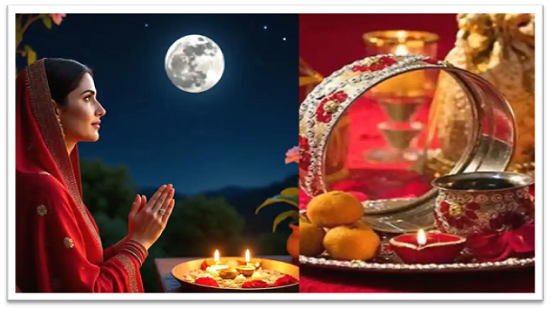
Karwa Chauth 2025 in Mumbai: Moonrise, Rituals, and the Essence of Devotion
As twilight descends on October 10, 2025, the skyline of Mumbai will shimmer with a serene glow — not just from the city lights, but from the lamps, faith, and devotion of countless women observing Karwa Chauth, one of the most significant festivals in the Hindu calendar.
Traditionally celebrated across northern India, Karwa Chauth — also known as Karak Chaturthi — holds deep emotional and spiritual meaning. It is a day when married women observe a fast from sunrise to moonrise, praying for the long life, happiness, and prosperity of their husbands. The festival transcends religion and region, evolving into a symbol of marital love, commitment, and togetherness.
In 2025, Karwa Chauth will fall on Friday, October 10, observed during the Krishna Paksha Chaturthi of the Kartik month. The festival’s rituals and rhythms bring together faith, family, and the beauty of tradition — from the first light of dawn to the final glimpse of the moon.
When Will the Moon Rise in Mumbai?
For devotees in Mumbai, the festival’s essence revolves around precise timing — especially the moonrise, which marks the conclusion of the fast.
Here are the key Karwa Chauth 2025 timings for Mumbai:
• Puja Muhurat: 05:57 PM – 07:11 PM
• Upavasa (Fasting) Time: 06:19 AM – 08:13 PM
• Moonrise: 08:55 PM
• Chaturthi Tithi Begins: 10:54 PM on October 9
• Chaturthi Tithi Ends: 07:38 PM on October 10
As per the Hindu lunar calendar, the moonrise timing varies slightly depending on location and local horizon visibility. Devotees in Mumbai often gather on terraces or open grounds to spot the first glimpse of Chand, as it signifies the moment to break their fast with heartfelt prayers and rituals.
The Rituals That Define Devotion
The day of Karwa Chauth begins before dawn with ‘Sargi’, a pre-dawn meal lovingly prepared by mothers-in-law for their daughters-in-law. This tradition not only provides nourishment for the long fast ahead but also strengthens the familial bond across generations.
After sunrise, women abstain from food and water throughout the day — a mark of unwavering devotion and discipline. The fast is more than physical abstinence; it represents spiritual purification, gratitude, and the reaffirmation of marital vows.
As the evening approaches, women gather together dressed in vibrant sarees and lehengas, their hands adorned with henna designs and bangles that symbolize prosperity. The community aspect of the celebration — where women sing traditional songs, exchange stories, and perform rituals — adds to the cultural warmth of the occasion.
During the evening puja, the stories of Veeravati, Karwa, and Savitri are narrated — legendary women whose courage, faith, and devotion symbolize the strength of womanhood. Each tale echoes the festival’s message: that love and determination can overcome even destiny itself.
The Symbolism Behind the Fast
At its heart, Karwa Chauth is more than a ritualistic observance — it’s a day of emotional reflection and gratitude. In Hindu tradition, fasting is considered a spiritual tool that channels the mind toward discipline and devotion.
For many women, the fast is not about sacrifice but about celebration — a celebration of love, companionship, and shared life. The act of waiting for moonrise, of looking through a sieve at the moon and then at one’s husband, symbolizes seeing divinity in the relationship and seeking blessings from the cosmic force that governs time and destiny.
As husbands offer the first sip of water or a morsel of food to their wives, it represents mutual respect and emotional intimacy — small gestures that carry the weight of centuries-old tradition.
Karwa Chauth and Its Evolving Essence in Urban India
In contemporary cities like Mumbai, Karwa Chauth has evolved beautifully, merging traditional values with modern lifestyles. For working women, professionals, and homemakers alike, the day remains a cherished pause — a reminder of roots and rituals amid the rush of city life.
Modern celebrations often blend faith and festivity: rooftop gatherings, temple visits, community pujas in residential complexes, and even digital ‘sargi’ exchanges through video calls for families separated by distance. The essence remains unchanged — the devotion and emotional bond that the festival nurtures.
Retail stores, beauty salons, and restaurants in Mumbai too reflect the festive mood, offering special Karwa Chauth deals and cultural events. Mehndi artists set up stalls in suburban markets, jewelry shops showcase symbolic bangles and bindis, and sweet shops prepare traditional delicacies like pheni, mathri, and halwa for the post-fast celebration.
Cultural Parallels and Shared Significance
Though primarily observed in North India, the spirit of Karwa Chauth finds resonance across regions through similar observances. In Maharashtra and Gujarat, Ahoi Ashtami and Vat Savitri Vrat echo similar sentiments of marital well-being and faith. The continuity of such traditions underscores the timeless Indian ethos — where rituals are not mere customs but expressions of love and resilience.
Interestingly, in recent years, some men have also chosen to fast alongside their wives — a gesture of equality and shared emotion, reinforcing that love and prayer know no hierarchy.
A Celebration of Love Under the Mumbai Sky
As the moon appears over the Arabian Sea at 8:55 PM, countless women across Mumbai will lift their eyes to the silver orb — their reflections mingling with devotion and joy. The moment marks not just the end of a fast, but the renewal of faith and affection.
Karwa Chauth, at its core, is a celebration of togetherness — of how traditions survive through tenderness, how rituals create meaning, and how love finds its light even in silence.
In a city that never sleeps, the stillness of Karwa Chauth night offers something rare — a pause that connects the personal with the divine, the present with the eternal.




